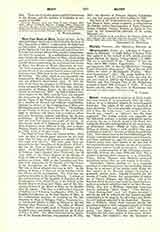

Most Pure Heart of Mary, FEAST OF THE. In its principal object this feast is identical with the feast of the “Inner Life of Mary”, celebrated by the Sulpitians on October 19. It commemorates the joys and sorrows of the Mother of God, her virtues and perfections, her love for God and her Divine Son, and her compassionate love for mankind. In a subordinate manner, its object is also the physical Heart of Mary, which, being part of her sinless and virginal body, is the symbol and sensible object representing the sentiments and virtues of Mary (see Devotion to the Heart of Mary). The feast originated with Blessed John Eudes as the patronal feast of his congregations of priests and nuns, and was, since 1644, kept at the seminary of Caen on October 20. The office, which is very beautiful, was composed by Blessed John Eudes in 1641, but its text was not definitely fixed before 1672. In 1647 the date of the feast was changed to February 8, the feast being solemnized publicly for the first time, with the permission of Bishop Ragny, at the cathedral of Autun on February 8, 1648. In 1668 Cardinal Vendome approved the office, and the feast was adopted the same year by the French Franciscans, the Benedictine Nuns of the Perpetual Adoration, and later by a number of dioceses and religious communities, contrary to decrees of the Congregation of Rites prohibiting the feast of the Heart of Mary. The bishops of the Church in France claimed at this period the right to institute new feasts, and to compose offices and new breviaries without consulting the Roman authorities. In 1672 Blessed John Eudes could state that the feast had spread over nearly all France. It was mostly kept on February 8, but at the Hotel Dieu of Quebec (since 1690) on July 3, and at Saint-Maclou, Rouen, on the Sunday after August 22 (Office pr. 1765; triple of the first class).
The Nuns of Notre Dame de Corbeil (February 8, 1787) were the first to obtain papal sanction for the feast from Pius VI (kept on August 22 as a double of the first class with octave). The same pope later approved it for the Carmelites of Saint-Denys (February 8), and for the Nuns of Fontevrault (Sunday after July 2). On March 22, 1799, it was granted to the city of Palermo (third Sunday after Pentecost); on August 13, 1805, to the Clerics Regular of the Mother of God; in 1806 to Siena; in 1807 to the Discalced Carmelites; on September 2, 1807, to the Capuchins and Hermits of St. Augustine for the Sunday after the Octave of the Assumption; on September 19, 1807, to Tuscany. The city of Rome adopted the feast in 1879. In the Society of Jesus it is observed on the Sunday within the Octave of the Assumption. The feast has not yet been extended to the entire Church. It is kept as the patronal feast of the Republic of Ecuador, of the Congregation of the Holy Ghost, of the Society of the Sacred Hearts of Jesus and Mary, and of the Missionary Society of the Heart of Mary on the Sunday after August 22. The feast is celebrated at Cosenza (Calabria) on February 7 (earthquake, 1783), by the English Benedictines on the first Sunday of May; in the ecclesiastical province of Lemberg on the last Saturday in May; at Bologna, Pescia, Volaterra etc., on the second Sunday in July; at Salerno on the last Sunday after Pentecost, etc. The office of Blessed John Eudes, universally used in France for over a hundred years, was finally approved for the Eudists (February 8) in 1861. The office contained in the Appendix of the Roman Breviary was granted on July 21, 1857; the dioceses of Palermo, Salerno, Catanzaro, etc., use that composed by Pere Gallifet in 1726. The feast of the Archconfraternity of the Immaculate Heart of Mary, refuge of sinners, is celebrated on the Sunday before Septuagesima at Paris, Chartres, Reims, Limoges, Vannes, Nantes, at Lucca in Toscana, in the ecclesiastical province of St. Louis, Missouri, etc.
FREDERICK G. HOLWECK


